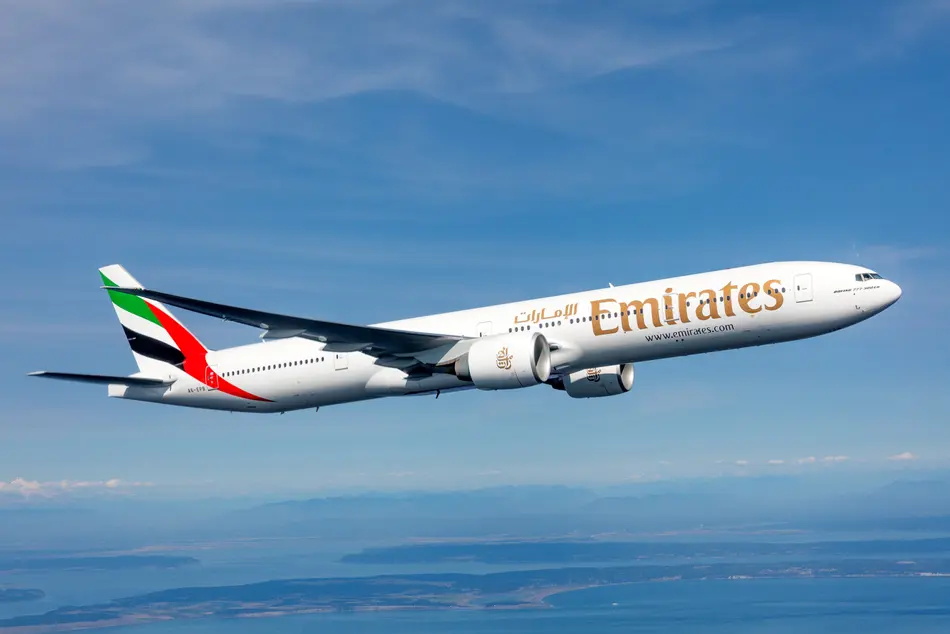Emirates Brings Manufacturing Expertise Closer To Home
For Emirates Airline’s long-haul fleet, the challenge is twofold: maintaining aging widebodies while looking beyond their likely life spans to the next big thing—literally.

For Emirates Airline’s long-haul fleet, the challenge is twofold: maintaining aging widebodies while looking beyond their likely life spans to the next big thing—literally.
The carrier has actively pushed both of the leading aircraft manufacturers for bigger twin-engine airliners, seeking a stretched Boeing 777X and a larger Airbus A350 (AW&ST Nov. 24-Dec. 7, p. 14). Emirates’ order for 65 more 777Xs at the Dubai Airshow came with a challenge to the airframer: Emirates would support a “feasibility study” to develop the 777-10 if it would also have the rights to convert its new order to that new variant.
In the meantime, with the out-of-production double-decker Airbus A380 still core to its operations, the Gulf carrier is working through a large retrofit program to maintain its older airframes for roughly another two decades. Emirates is navigating persistent supply chain constraints and investing in related capabilities, but it is not alone in pursuit of broader self-sufficiency. Many airlines are increasingly looking to bring maintenance, repair and overhaul (MRO) expertise closer to home, if not in-house—a trend evident at this year’s Dubai Airshow in both airline commentary and signed agreements.
“Often in the past, when there was an abundance of material in the market, we could find solutions within one organization or between two organizations,” Christopher Vrydag, Etihad Airways’ director of technical supply chain, said during a panel discussion at the show. “But today, we need to connect the collective brains of the industry to resolve the issues, which are far more complex.”
As the industry continues to grow, “we’re going to have more capacity constraints coming in the next four or five years,” he added. “Today, we need to build more resilience.”
Emirates announced deals at the show with key suppliers in support of expanding self-sufficiency amid its ongoing widebody retrofit program. That includes a memorandum of understanding with Rolls-Royce, under which the carrier is to build a facility to complete fan case repairs for its Trent 900 engines beginning in 2027.
“With Emirates’ plans to continue operating our Airbus A380 fleet into the 2040s, we wanted to secure our own engine maintenance capabilities,” said Ahmed Safa, head of engineering and MRO at the airline.
Additionally, under a joint industrial cooperation agreement announced at the show, key supplier Safran Seats intends to establish manufacturing and assembly in Dubai in a facility slated to be complete by late 2027 to support Emirates and other carriers in the region. The enterprise is to focus initially on business and economy seats for retrofits, but it is also expected to have assembly capability of up to 1,000 business-class seats per year to start with.
Emirates has slated 219 aircraft for full refurbishment, 110 A380s and 109 777s; 76 have been completed to date. Today, it takes approximately 22 days to retrofit one A380 and about 18 days to retrofit a 777. But recent receipt of Design Organization Approval (DOA) from the United Arab Emirates’ General Civil Aviation Authority could improve those timelines by expanding Emirates Engineering’s existing capabilities for minor modifications to include major cabin reconfigurations and complex design changes.
The DOA approval announced Nov. 20 also boosts the carrier’s autonomy, covering Airbus and Boeing aircraft types and “providing Emirates with greater control over timelines, costs and innovation priorities,” the airline said. The expanded approval also supports Emirates Engineering’s “future parts and component production and manufacturing ambitions,” the carrier added, which should enable it to develop intellectual property for components that can then be manufactured locally.
While the agreements strengthen Dubai’s local aerospace capabilities, other airlines are navigating supply chain challenges at different scales. That includes building spare parts inventories, leveraging data for predictive supply chain management and enhancing supplier collaboration, airline representatives said at the airshow. While some carriers are moving away from traditional transactional relationships, the underlying goal remains consistent: take a longer-term view to build operational resilience.
For Emirates, building out regional capabilities is key as it prepares for growth. And more is still to come.
“Our goal is to further develop aerospace manufacturing to attract component suppliers, technology companies and talented, skilled professionals from around the world,” Emirates Chairman and CEO Sheikh Ahmed Bin Saeed Al Maktoum said on signing the memorandum of understanding with Safran Seats. “The [United Arab Emirates] has built one of the world’s most successful aviation industries, and now it’s time to build the manufacturing capabilities to match.”


